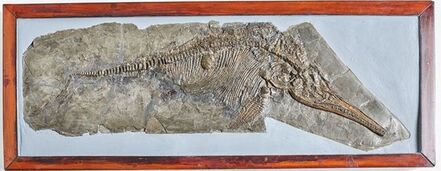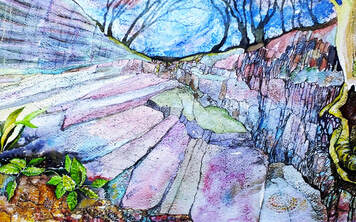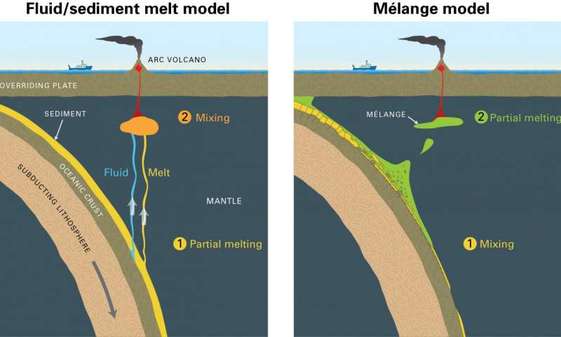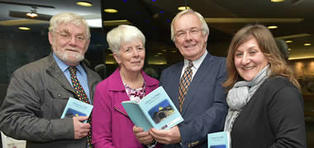Good news:- Now you can find us on Facebook at
https://www.facebook.com/GalwayGeologicalAssociation
######################################################
"Everyone is entitled to his own opinion, but not his own facts."
Senator Daniel Patrick Moynihan.
#################################################
Senator Daniel Patrick Moynihan.
#################################################
“If only the geologists would leave me alone, I could do very well, but those dreadful hammers! I hear the clink of them at the end of every cadence of the Bible verses.” - John Ruskin, 1851.
≠≠≠≠≠≠≠≠≠≠≠≠≠≠≠≠≠≠≠≠≠≠≠≠≠≠≠≠≠≠≠≠≠≠≠≠≠≠≠≠≠≠≠≠≠≠≠≠≠≠≠≠≠≠≠≠
≠≠≠≠≠≠≠≠≠≠≠≠≠≠≠≠≠≠≠≠≠≠≠≠≠≠≠≠≠≠≠≠≠≠≠≠≠≠≠≠≠≠≠≠≠≠≠≠≠≠≠≠≠≠≠≠
"We live in a society exquisitely dependent on science and technology, in which hardly anyone knows anything about science or technology." - Carl Sagan
≠≠≠≠≠≠≠≠≠≠≠≠≠≠≠≠≠≠≠≠≠≠≠≠≠≠≠≠≠≠≠≠≠≠≠≠≠≠≠≠≠≠≠≠≠≠≠≠≠≠≠≠≠
If you have any comments to add about the items here, please let us know.
≠≠≠≠≠≠≠≠≠≠≠≠≠≠≠≠≠≠≠≠≠≠≠≠≠≠≠≠≠≠≠≠≠≠≠≠≠≠≠≠≠≠≠≠≠≠≠≠≠≠≠≠≠
Connemara from space
An astronaut aboard the International Space Station shot this photograph of the West of Ireland, and the Atlantic coastal islands. It can be rare to see any part of Ireland from orbit without clouds!
earthobservatory.nasa.gov/images/92425/connemara-national-park?src=eoa-iotd
~~~~~~~~~~~~~~~~~~~~~~~~~~~~~~~~~~~~~~~~~~~~~~~~~~~~~~~~~~~~~

Why is the ground exploding in Siberia?
On a remote peninsular in the Arctic circle, enormous wounds are appearing in the permafrost and have started to worry scientists. Research teams from Russia and the United States are racing to find out what this means for Siberia, and potentially the rest of the world.
www.bbc.com/reel/playlist/ultimate-world?vpid=p097w5p5
On a remote peninsular in the Arctic circle, enormous wounds are appearing in the permafrost and have started to worry scientists. Research teams from Russia and the United States are racing to find out what this means for Siberia, and potentially the rest of the world.
www.bbc.com/reel/playlist/ultimate-world?vpid=p097w5p5
New research on plate tectonics.
|
The glacially slow widening of the Atlantic Ocean is due to the ongoing movement of Earths tectonic plates, as the plates underneath the Americas pull apart from those underneath Europe and Africa.
The deep, geophysical forces underpinning this epic phenomenon remain far from fully understood, but researchers may have just identified an important contributor to what's happening. In a new study, scientists suggest that mid-ocean ridges – mountainous formations that emerge along the seafloor in-between tectonic plates – could be more implicated in the transfer of material between the upper and lower mantle beneath Earth's crust than we previously realised. |
|
"Chris Jackson on sustainable geology."
Here's another episode of The Life Scientific from BBC Radio 4, introduced by Prof. Jim Al Kalili. 12 January 2021. Chris Jackson is the kind of scientist who just loves to get out into the landscape. He’s often introduced as ‘geologist and adventurer’. For the past five years he’s been Professor of Basin Analysis in the Department of Earth Sciences and Engineering at Imperial College London and he’s now about to move back to the University of Manchester, where he studied as a student, to become Professor of Sustainable Geoscience. Chris talks to Jim al-Khalili about working in the oil and gas exploration industry at the start of his career, searching for massive deposits of salt deep inside the earth and his experience of being a black geologist. |
|
Who was the real Mary Anning?
Francis Lee, who wrote and directed the film starring Kate Winslet and Saoirse Ronan, readily admits this is not a biopic - and stands by the decision to depict a same-sex love story, despite the fact that Anning's romantic inclinations are lost to history. If we ever get to go to the cinema again we'll be able to make up our own minds. |
And there's a campaign to erect a statue to Mary in her home town of Lyme Regis - www.maryanningrocks.co.uk/
|
Chronicles of Charnia.
Scientists had long been befuddled by the apparent absence of fossils from the Earth’s oldest strata. In his seminal book, On the Origin of Species, Darwin wrote: “To the question why we do not find rich fossiliferous deposits belonging to these assumed earliest periods, I can give no satisfactory answer…” When an ancient, unexpected imprint is discovered in a stone quarry, scientists endeavor to explain its mysterious origin. www.damninteresting.com/chronicles-of-charnia/ |
|
An unusual use for Quartz
In the Mojave Desert, a translucent crystal offers bryophytes much-needed respite from the heat of the sun.
To humans, a desert oasis may conjure an image of a blue pool encircled by a coronet of palm trees. But to certain mosses, an oasis takes the form of a pebble of milky quartz. The cloudy crystal dilutes the sun’s piercing ultraviolet rays and, in the dry desert heat, traps moisture beneath it, creating a microclimate perfect for a moss. https://www.nytimes.com/2020/07/29/science/moss-quartz-biology-syntrichia.html |
|
|
The Petty Feud That Almost Destroyed Paleontology
Nothing better than an intense rivalry between scientists...right? Well, that's exactly what happened with paleontologists Edward Drinker Cope and Othniel Charles Marsh -- two men who really take the cake for petty feuds. This fight, also known as The Bone Wars or The Great Dinosaur Rush, was so heated that it devolved into bribery, theft, and destruction that almost ruined paleontology. |
 https://theconversation.com/how-we-discovered-that-an-asteroid-collision-in-space-466m-years-ago-boosted-life-on-earth-123639
https://theconversation.com/how-we-discovered-that-an-asteroid-collision-in-space-466m-years-ago-boosted-life-on-earth-123639
An asteroid collision in space 466m years ago boosted life on Earth.
Something mysterious happened nearly half a billion years ago that triggered one of the most important changes in the history of life on Earth. Suddenly, there was an explosion of species, with the biodiversity of invertebrate animals increasing from a very low level to something similar to what we see today. The most popular explanation for this “Great Ordovician Biodiversification Event” is that it was a result of an uncomfortably hot Earth cooling and eventually heading into an ice age.
But what actually triggered the change in temperature? A new paper shows that its onset coincided exactly with the largest documented asteroid breakup in the asteroid belt during the past two billion years, caused by a collision with another asteroid or a comet.
From The Conversation, September 18, 2019
Something mysterious happened nearly half a billion years ago that triggered one of the most important changes in the history of life on Earth. Suddenly, there was an explosion of species, with the biodiversity of invertebrate animals increasing from a very low level to something similar to what we see today. The most popular explanation for this “Great Ordovician Biodiversification Event” is that it was a result of an uncomfortably hot Earth cooling and eventually heading into an ice age.
But what actually triggered the change in temperature? A new paper shows that its onset coincided exactly with the largest documented asteroid breakup in the asteroid belt during the past two billion years, caused by a collision with another asteroid or a comet.
From The Conversation, September 18, 2019
|
Geologists get called 'dirty polluters', but they're needed to fight climate change.
When people hear "we are geologists", they often ask if they have found any oil lately. Sadly—and wrongly—the most common view of geology as a profession is that its primary role is in the discovery and extraction of fossil fuels.But if we are to radically reduce emissions and move towards a low carbon economy, we'll need geologists. |
What are Plate Boundaries?
Here is a short, but useful, explanation of the different types of plate boundaries from 'geologypage.com'
http://www.geologypage.com/2019/03/what-are-the-different-types-of-plate-tectonic-boundaries.html
Here is a short, but useful, explanation of the different types of plate boundaries from 'geologypage.com'
http://www.geologypage.com/2019/03/what-are-the-different-types-of-plate-tectonic-boundaries.html
|
The Chicxulub asteroid impact.
Scientists have found an extraordinary snapshot of the fallout from the asteroid impact that wiped out the dinosaurs 66 million years ago. Excavations in North Dakota reveal fossils of fish and trees that were sprayed with rocky, glassy fragments that fell from the sky. The deposits show evidence also of having been swamped with water - the consequence of the colossal sea surge that was generated by the impact. https://www.bbc.com/news/science-environment-47755275 |
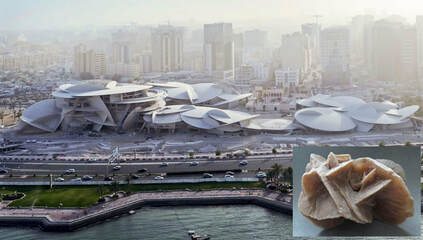
A Museum in the desert inspired by a desert rose.
This pile-up of flying saucers is the new National Museum of Qatar, an astonishing creation by French architect Jean Nouvel
It took 18 years to build, has nearly a mile of galleries and is inspired by the form taken by calcium sulphate crystals (inset) that grow in desert sand.
www.theguardian.com/artanddesign/2019/mar/27/flying-saucers-have-landed-qatar-supersized-national-museum
This pile-up of flying saucers is the new National Museum of Qatar, an astonishing creation by French architect Jean Nouvel
It took 18 years to build, has nearly a mile of galleries and is inspired by the form taken by calcium sulphate crystals (inset) that grow in desert sand.
www.theguardian.com/artanddesign/2019/mar/27/flying-saucers-have-landed-qatar-supersized-national-museum

Mary Anning: how a poor, Victorian woman became one of the world’s greatest palaeontologists
Mary Anning was a major contributor to the sciences of geology and paleontology, just as they were gathering steam – becoming established in museums and gaining worldwide interest. Historian Hugh Torrens, in his 1995 presidential address about Anning for the British Society for the History of Science, chose the epithet the “greatest fossilist the world has known” for the title of his talk. The people of Lymme Regis in Dorset, Mary's home town, Are raising funds to erect a statue to her. Not before time, perhaps.
theconversation.com/mary-anning-how-a-poor-victorian-woman-became-one-of-the-worlds-greatest-palaeontologists-105183
Mary Anning was a major contributor to the sciences of geology and paleontology, just as they were gathering steam – becoming established in museums and gaining worldwide interest. Historian Hugh Torrens, in his 1995 presidential address about Anning for the British Society for the History of Science, chose the epithet the “greatest fossilist the world has known” for the title of his talk. The people of Lymme Regis in Dorset, Mary's home town, Are raising funds to erect a statue to her. Not before time, perhaps.
theconversation.com/mary-anning-how-a-poor-victorian-woman-became-one-of-the-worlds-greatest-palaeontologists-105183
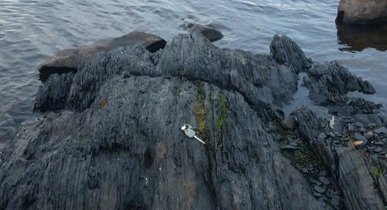
Drought unveils unseen rocks in Co Clare.
Dr Eamon Doyle, the Burren and Cliffs of Moher Geopark and Clare County Council geologist has been in the news again. As a result of falling water levels in Lickeen Lake heavily folded rocks have been exposed that are the reason that the lake is deep enough to supply water to most of County Clare. The rocks are sandstones and shales of the Gull Island Formation, so not limestone. The limited exposure indicates they are folded with some small scale faults, and the orientation suggests it is part of the Variscan suite of structures that are more obvious in places like the Bridges of Ross, further south (and the more open gentle folds of the Burren limestone). They would have eroded faster than the more competent surrounding rocks and formed the depression which is now filled with water to form the lake.
Dr. Doyle says "This is a great example of how the 300 million years of geological history has a direct impact on our lives today."
From www.breakingnews.ie tinyurl.com/y8loer94
Dr Eamon Doyle, the Burren and Cliffs of Moher Geopark and Clare County Council geologist has been in the news again. As a result of falling water levels in Lickeen Lake heavily folded rocks have been exposed that are the reason that the lake is deep enough to supply water to most of County Clare. The rocks are sandstones and shales of the Gull Island Formation, so not limestone. The limited exposure indicates they are folded with some small scale faults, and the orientation suggests it is part of the Variscan suite of structures that are more obvious in places like the Bridges of Ross, further south (and the more open gentle folds of the Burren limestone). They would have eroded faster than the more competent surrounding rocks and formed the depression which is now filled with water to form the lake.
Dr. Doyle says "This is a great example of how the 300 million years of geological history has a direct impact on our lives today."
From www.breakingnews.ie tinyurl.com/y8loer94
|
Welcome to the Meghalayan Age
- a new phase in Earths' history? Some geologists have proposed classifying the last 4,200 years as being a distinct age in the story of our planet. They are calling it the Meghalayan Age, the onset of which was marked by a mega-drought that crushed a number of civilisations worldwide. The International Chronostratigraphic Chart, the famous diagram depicting the timeline for Earth's history (seen on many classroom walls) will be updated. www.bbc.com/news/science-environment-44868527 See also the infographic from The Times of India. timesofindia.indiatimes.com/india/how-meghalaya-gave-its-name-to-4200-yrs-of-earths-age/articleshow/65098350.cms |

|
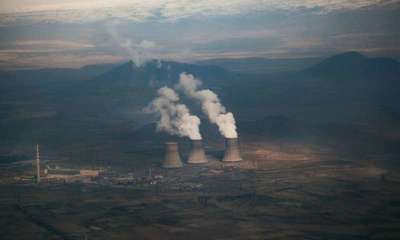
But then again, perhaps we're still in the Anthropocene?
Controversy rages amongst geologists as what the present period of Earth's history should be called. Over the past decade, more and more scientists have agreed that human impact on Earth is so significant that we have entered a completely new geological phase, called the Anthropocene.
Read more at: https://phys.org/news/2018-08-anthropocene-meghalayanwhy-geologists-humans-nature.html#jCp

How to build a Dinosaur in
1 minute 18 seconds!
This time-lapse video from the BBC shows the assembly of Dippy the Diplodicus from the Natural history Museum as it goes on tour around the UK.
www.bbc.com/news/av/science-environment-43001790/timelapse-records-dippy-s-rise-in-dorset
1 minute 18 seconds!
This time-lapse video from the BBC shows the assembly of Dippy the Diplodicus from the Natural history Museum as it goes on tour around the UK.
www.bbc.com/news/av/science-environment-43001790/timelapse-records-dippy-s-rise-in-dorset

How the Ice Age Shaped New York.
A fascinating and readable description of the glacial landscape underlying New York and the processes involved in it's formation. From the New York Times.
http://tinyurl.com/yd53amzc
A fascinating and readable description of the glacial landscape underlying New York and the processes involved in it's formation. From the New York Times.
http://tinyurl.com/yd53amzc

Fossils Reveal an Ancient Climate Catastrophe.
We Need to Pay Attention
The PETM is the Paleocene Eocene Thermal Maximum - an ungainly name for the time that's considered one of Earth's best analogues to this era of modern, human-caused global warming. In a matter of a few thousand years, huge amounts of carbon were injected into the atmosphere, causing global temperatures to rise between 5 and 8 degrees Celsius.
The rapid climate change disrupted weather, transformed landscapes, acidified oceans and triggered extinctions. It took more than 150,000 years for the world to recover. tinyurl.com/y9pgdznf
We Need to Pay Attention
The PETM is the Paleocene Eocene Thermal Maximum - an ungainly name for the time that's considered one of Earth's best analogues to this era of modern, human-caused global warming. In a matter of a few thousand years, huge amounts of carbon were injected into the atmosphere, causing global temperatures to rise between 5 and 8 degrees Celsius.
The rapid climate change disrupted weather, transformed landscapes, acidified oceans and triggered extinctions. It took more than 150,000 years for the world to recover. tinyurl.com/y9pgdznf

The Great African Rift Valley is still active.Kenya is slowly splitting at the Rift Valley, geologists have said after massive Earth movements on Monday morning left deep fissures in Narok County.
At the intersection of the damage with the busy Mai Mahiu-Narok road, what was recently an even plain of fertile, arable land has been reduced to a rugged expanse, with a huge tear that is as much as 50 feet deep and more than 20 metres wide running through it.
http://tinyurl.com/ycfrd4c4 www.youtube.com/watch?v=2Ps-u3BgR-0
tinyurl.com/y9fzebd7
Or is it? For an alternative view, read this article from the Guardian, April 8th. http://tinyurl.com/y9ucolx3
At the intersection of the damage with the busy Mai Mahiu-Narok road, what was recently an even plain of fertile, arable land has been reduced to a rugged expanse, with a huge tear that is as much as 50 feet deep and more than 20 metres wide running through it.
http://tinyurl.com/ycfrd4c4 www.youtube.com/watch?v=2Ps-u3BgR-0
tinyurl.com/y9fzebd7
Or is it? For an alternative view, read this article from the Guardian, April 8th. http://tinyurl.com/y9ucolx3

Well done Eamon.
A new fossilised starfish has been discovered in Connemara - and tests show it is 435 million years old!
It was found in the Maam Valley of Galway and named ‘Crepidosoma doyleii’ in honour of its discoverer Dr Eamon Doyle, geologist for the Burren and Cliffs of Moher UNESCO Global Geopark and Clare County Council and well known to members of the GGA.
http://tinyurl.com/ya2fp4gv
A new fossilised starfish has been discovered in Connemara - and tests show it is 435 million years old!
It was found in the Maam Valley of Galway and named ‘Crepidosoma doyleii’ in honour of its discoverer Dr Eamon Doyle, geologist for the Burren and Cliffs of Moher UNESCO Global Geopark and Clare County Council and well known to members of the GGA.
http://tinyurl.com/ya2fp4gv

Fossil Discovery Reveals a New Dinosaur
With Iridescent Feathers
The discovery that dinosaurs were feathery, not leathery, means we've had to rethink how they might have looked - and now there's evidence that at least one dinosaur could have been as brilliantly coloured as some of the most jewel-hued modern birds.
www.sciencealert.com/newly-discovered-dinosaur-caihong-juji-rainbow-feathers
With Iridescent Feathers
The discovery that dinosaurs were feathery, not leathery, means we've had to rethink how they might have looked - and now there's evidence that at least one dinosaur could have been as brilliantly coloured as some of the most jewel-hued modern birds.
www.sciencealert.com/newly-discovered-dinosaur-caihong-juji-rainbow-feathers

What is the difference between Magma and Lava?
This picture illustrates it tastily!
For more geology jokes try:-
http://tinyurl.com/y9qv8oy4
|
Scientists Are Mapping an Atlas of The Underworld Hidden Far Beneath Our Feet And you can take a look.
For as long as humans have been around we've been facinated by the world hiding underneath the surface of the Earth, and now scientists are systematically mapping the positions of the tectonic plates that have been pushed deeper into the planet's core. |

Plate tectonics: When we discovered how the Earth really works.
It's 5o years since the theory of plate tectonics was first published in the journal Nature by Dan McKenzie with Robert Parker, Cambridge University graduates. Building on the work from 1915 on Continetal Drift by Alfred Wegener , they realised that it was subduction at the plate margins that "pulled" the spreading rather than up-welling of material at the mid ocean ridges "pushing" them apart.
www.bbc.com/news/science-environment-41472281
~~~~~~~~~~~~~~~~~~~~~~~~~~~~~~~~~~~~~~~~~~~~~~~~~~~~~~~
It's 5o years since the theory of plate tectonics was first published in the journal Nature by Dan McKenzie with Robert Parker, Cambridge University graduates. Building on the work from 1915 on Continetal Drift by Alfred Wegener , they realised that it was subduction at the plate margins that "pulled" the spreading rather than up-welling of material at the mid ocean ridges "pushing" them apart.
www.bbc.com/news/science-environment-41472281
~~~~~~~~~~~~~~~~~~~~~~~~~~~~~~~~~~~~~~~~~~~~~~~~~~~~~~~
Here's a Youtube video, with commentary, about taking a sediment core in Lough Feagh, N. Mayo. It was carried out during August, 2017 as part of the Marine Institute Research project BEYOND2020.

Rock Music
Some unusual boulder fields lay scattered across Pennsylvania and New Jersey. What’s special about them? The rocks ring like bells when struck with a hammer.Despite the rocks’ popularity, the question of why they ring has been largely abandoned by scientists. The only rudimentary answers appear in an obscure publication in 1970 by a Rutgers researcher who barely left a digital trace. scienceline.org/2017/06/video-rock-music-2/
Some unusual boulder fields lay scattered across Pennsylvania and New Jersey. What’s special about them? The rocks ring like bells when struck with a hammer.Despite the rocks’ popularity, the question of why they ring has been largely abandoned by scientists. The only rudimentary answers appear in an obscure publication in 1970 by a Rutgers researcher who barely left a digital trace. scienceline.org/2017/06/video-rock-music-2/
|
Well now... They have obviously never heard of our famous Musical Bridge over the Owenmore River at Bellacorick in N. Mayo have they? The capstone slabs of hard limestone ring out when struck. If you haven't heard of it either then stop and play it next time you're driving on the N59 near the Ballycroy National Park, grid ref 54.116667, -9.583333. It's magic! en.wikipedia.org/wiki/Bellacorick |

"Galway Bay less than 1000 years old" say NUI Galway boffins.
Dr Karen Malloy and Prof. Michael O'Connell have an article in the Irish Times today (5 August 2017) about their researches into the age of sea level rise that created Galway Bay as we see it today. Evidence from exposed pine stumps and peat beds suggest that the present extent of the bay may be so “recent” that the bay may be just 1,000 years “young”, according to their research published in the international journal The Holocene, entitled Mid- and Late-Holocene Environmental Change in Western Ireland, (June 2017). tinyurl.com/ycepapqf
~~~~~~~~~~~~~~~~~~~~~~~~~~~~~~~~~~~~~~~~~~~~~~~
Dr Karen Malloy and Prof. Michael O'Connell have an article in the Irish Times today (5 August 2017) about their researches into the age of sea level rise that created Galway Bay as we see it today. Evidence from exposed pine stumps and peat beds suggest that the present extent of the bay may be so “recent” that the bay may be just 1,000 years “young”, according to their research published in the international journal The Holocene, entitled Mid- and Late-Holocene Environmental Change in Western Ireland, (June 2017). tinyurl.com/ycepapqf
~~~~~~~~~~~~~~~~~~~~~~~~~~~~~~~~~~~~~~~~~~~~~~~
Donegal earthquake compared to washing machine!
www.theirishworld.com/donegal-earthquake-milford-washing-machine/
~~~~~~~~~~~~~~~~~~~~~~~~~~~~~~~~~~~~~~~~~~~~~~~~~~~~~~
The GGA recently hosted a talk by Davide Gallazzi entitled "Wine and Geology" in which he exposed some of the geo-babble around the subject of vineculture. You are invited to read a fine example here and then to read Davide's take-down:--
< You can't understand it because it makes no sense at all:
"The vineyards grow inside a fertile, amphitheatre-shaped valley that’s closed in by the Alps on one side and by Lake Iseo on the other. A silicious, extinct glacier once covered the whole area, out of which precious minerals are still abundant. When the glacier retreated during the last Ice Age, it left behind huge balls of peat and rock debris, fossilized over millennia, that resemble shards of fallen meteorites."
The first sentence makes sense, the actual climatic advantages of growing wine on certain slopes south facing and protected from cold wind: basic stuff.
But then it gets interesting:
"A silicious glacier": hence made of silica?!!! Wow, that would be a geological wonder! Pity it is now extinct.
"Precious metals are still abundant": so this is the famous Eldorado, forget about the gold mines of South America! That's why the Spaniards wanted to control the north of Italy centuries ago! And these precious metals all go into the wine? So when you drink Franciacorta you actually drink a piece of a jewelry? That surely is why it is that expensive?!
"When the glacier retreated during the last Ice Age..." (I actually thought that glaciers expanded during the Ice Age,but then this is a silicious glacier, so...) "it left behind huge balls of peat and rock debris, fossilised over millennia".Wow, actual balls of peat and debris and fossilised as well! Careful if they get rolling downhill (or maybe uphill, given how special this area is). I guess fossilised over millennia as writing millions of years would be a bit of an over-statement in such an otherwise modest article.
And to finish with the icing, the hint to meteorites. Are these the meteorites that caused the extinction of the silicious glacier? I wonder what the dinosaurs may have thought of it.
It is another example of how to use geology to write nonsense but making it sounding fascinating. But then, looking at the actual geological references, I think the writer must have been sleeping during the geography classes in secondary school. >
Cheers!
~~~~~~~~~~~~~~~~~~~~~~~~~~~~~~~~~~~~~~~~~~~~~
The GGA recently hosted a talk by Davide Gallazzi entitled "Wine and Geology" in which he exposed some of the geo-babble around the subject of vineculture. You are invited to read a fine example here and then to read Davide's take-down:--
< You can't understand it because it makes no sense at all:
"The vineyards grow inside a fertile, amphitheatre-shaped valley that’s closed in by the Alps on one side and by Lake Iseo on the other. A silicious, extinct glacier once covered the whole area, out of which precious minerals are still abundant. When the glacier retreated during the last Ice Age, it left behind huge balls of peat and rock debris, fossilized over millennia, that resemble shards of fallen meteorites."
The first sentence makes sense, the actual climatic advantages of growing wine on certain slopes south facing and protected from cold wind: basic stuff.
But then it gets interesting:
"A silicious glacier": hence made of silica?!!! Wow, that would be a geological wonder! Pity it is now extinct.
"Precious metals are still abundant": so this is the famous Eldorado, forget about the gold mines of South America! That's why the Spaniards wanted to control the north of Italy centuries ago! And these precious metals all go into the wine? So when you drink Franciacorta you actually drink a piece of a jewelry? That surely is why it is that expensive?!
"When the glacier retreated during the last Ice Age..." (I actually thought that glaciers expanded during the Ice Age,but then this is a silicious glacier, so...) "it left behind huge balls of peat and rock debris, fossilised over millennia".Wow, actual balls of peat and debris and fossilised as well! Careful if they get rolling downhill (or maybe uphill, given how special this area is). I guess fossilised over millennia as writing millions of years would be a bit of an over-statement in such an otherwise modest article.
And to finish with the icing, the hint to meteorites. Are these the meteorites that caused the extinction of the silicious glacier? I wonder what the dinosaurs may have thought of it.
It is another example of how to use geology to write nonsense but making it sounding fascinating. But then, looking at the actual geological references, I think the writer must have been sleeping during the geography classes in secondary school. >
Cheers!
~~~~~~~~~~~~~~~~~~~~~~~~~~~~~~~~~~~~~~~~~~~~~

Davide also draws our attention to the threat of "action" from the Campi Flegrei volcano in southern Italy which may be closer to an eruption than previously thought, according to new research by UCL and the Vesuvius Observatory in Naples. - See more at: https://www.ucl.ac.uk/news/news-articles/0517/150517-Campi-Flegrei-volcano-eruption#sthash.6BKXcoHB.dpuf
and: https://www.nature.com/articles/ncomms15312
and for a good bedtime read: http://onlinelibrary.wiley.com/doi/10.1002/2016GC006569/full
~~~~~~~~~~~~~~~~~~~~~~~~~~~~~~~~~~~~~~~~~~~~~~~~~~~
and: https://www.nature.com/articles/ncomms15312
and for a good bedtime read: http://onlinelibrary.wiley.com/doi/10.1002/2016GC006569/full
~~~~~~~~~~~~~~~~~~~~~~~~~~~~~~~~~~~~~~~~~~~~~~~~~~~

The scientist who discovered the core of the Earth.
The "Grande Dame” of seismology, Inge Lehmann, began her career at a time when few women held senior positions in science. But that did not stop her from being the first to provide evidence of the Earth’s inner core in 1936.
http://sciencenordic.com/female-scientist-who-discovered-core-earth
|
The shallow sea covering the target site meant colossal volumes of sulphur (from the mineral gypsum) were injected into the atmosphere, extending the "global winter" period that followed the immediate firestorm. Had the asteroid struck a different location, the outcome might have been very different. Had the asteroid struck a few moments earlier or later, rather than hitting shallow coastal waters it might have hit deep ocean.
www.bbc.com/news/science-environment-39922998 |
The 30 seconds that killed the dinosaurs.
|
|
A new haul of ancient human remains has been described from an important cave site in South Africa.
It may be remembered that NUI Galway hosted a lecture by Dr. Tracey Kivell on Homo naledi from the Rising Star Cave at the IGRM59 conference last year (see the page under "Galleries"). Now there is news of more exiting finds from the site. See the article from the BBC http://www.bbc.com/news/science-environment-39842975 and the series of papers on the eLife site http://tinyurl.com/n6vgu2j |
A 300 million year old shark tooth fossil has been found on the north Clare coastline at Doolin, Co Clare.
This very rare and significant find was made by Dr. Eamon Doyle, a geologist with the Burren & Cliffs of Moher UNESCO global Geopark. Dr Doyle said: “Fossil sharks teeth of this age are very rare in Ireland and so it extends the known range of fossil sharks in Ireland. Equally significant is the information it gives us about the biodiversity of these ancient seas.” The fossil will be placed on public display on 25 May at "There’s Life in the Old Rocks of Clare" in Ennistymon Public Library. The event will mark the start of the annual Burren Rocks Festival.
|

x http://www.thejournal.ie/shark-tooth-of-irelands-ancient-seas-discovered-3384681-May2017/?utm_source=shortlink http://www.burrengeopark.ie/ http://www.burrengeopark.ie/discover-and-experience/festivals-and-events/the-burren-rocks/ |
Are volcanic arcs formed by deep melting of rock mixtures?
Beneath the ocean, massive tectonic plates collide and grind against one another, which drives one below the other. This powerful collision, called subduction, is responsible for forming volcanic arcs that are home to some of Earth's most dramatic geological events, such as explosive volcanic eruptions and mega earthquakes.
A new study published in the journal Science Advances changes our understanding of how volcanic arc lavas are formed, and may have implications for the study of earthquakes and the risks of volcanic eruption.
Read more at: https://phys.org/news/2017-04-volcanic-arcs-deep-mixtures.html#jCp
-------------------------------------------------------------------
A new study published in the journal Science Advances changes our understanding of how volcanic arc lavas are formed, and may have implications for the study of earthquakes and the risks of volcanic eruption.
Read more at: https://phys.org/news/2017-04-volcanic-arcs-deep-mixtures.html#jCp
-------------------------------------------------------------------

The 6 Biggest Meteorites to Ever to Be Found on Earth.
Often, when rocks from space hurtle towards Earth, they burn up in the atmosphere before actually reaching us. The ones that vaporize become a meteor - or shooting star.
The lucky few that make the whole journey land on Earth as meteorites. Once on the surface, these meteorites can exist as a single rock for thousands of years, except for a little weathering.
From Science Alert.com goo.gl/xq3WXS
(PS, Check out "Maire's Namibia Trip" on a sub-page above)
Often, when rocks from space hurtle towards Earth, they burn up in the atmosphere before actually reaching us. The ones that vaporize become a meteor - or shooting star.
The lucky few that make the whole journey land on Earth as meteorites. Once on the surface, these meteorites can exist as a single rock for thousands of years, except for a little weathering.
From Science Alert.com goo.gl/xq3WXS
(PS, Check out "Maire's Namibia Trip" on a sub-page above)

Chart of the basic chemical make-up of igneous rock types from Dr. Sadhbh Baxter's Rock ID course, Feb 2017.
------------------------------------------------------------------
------------------------------------------------------------------
Stunning video reveals the massive 'firehose of lava' flowing from Hawaii's Kilauea volcano into the sea. Molten lava from the volcano is dumping directly into the Pacific. The massive lava stream is roughly 1-2 meters wide, spewing as a 'single large spout'. This creates dangerous explosions as the hot lava interacts with the cool sea. The "steam" rising from the lava's interaction with the sea is fairly strong hydrochloric acid vapour. Do follow the YouTube links to more interesting lava related videos.
https://youtu.be/1QMtcmGpSJ8
..........................................................................................................................................
https://youtu.be/1QMtcmGpSJ8
..........................................................................................................................................
The hunt for the Anthropocene.
|
And if you liked that, listen to these other programs in the series:-
Nick Fraser on Triassic reptiles - www.bbc.co.uk/programmes/b08lh5yp
Tamsin Mather on what volcanic plumes reveal about our planet - www.bbc.co.uk/programmes/b08t0d3w
----------------------------------------------------------------------------------------------------
Nick Fraser on Triassic reptiles - www.bbc.co.uk/programmes/b08lh5yp
Tamsin Mather on what volcanic plumes reveal about our planet - www.bbc.co.uk/programmes/b08t0d3w
----------------------------------------------------------------------------------------------------

A new picture of the last ice age.
An animated GIF of the extent of the last period of glaciation over Europe.
At the peak of the last ice age, a vast ice sheet covered northern Europe, spanning from the British Isles, across Scandinavia and into Russia in the east and the Barents Sea in the north. A new reconstruction of this ice sheet shows the interaction between climate and glaciers—how the ice sheet grows and retreats
Read more at:
http://phys.org/news/2016-03-picture-ice-age.html
An animated GIF of the extent of the last period of glaciation over Europe.
At the peak of the last ice age, a vast ice sheet covered northern Europe, spanning from the British Isles, across Scandinavia and into Russia in the east and the Barents Sea in the north. A new reconstruction of this ice sheet shows the interaction between climate and glaciers—how the ice sheet grows and retreats
Read more at:
http://phys.org/news/2016-03-picture-ice-age.html

Was the End Permian extinction caused by Microbes?
http://www.dailygalaxy.com/my_weblog/2016/01/90-extinct-was-largest-of-earths-five-mass-extinctions-caused-by-microbes-weekend-feature.html
http://www.dailygalaxy.com/my_weblog/2016/01/90-extinct-was-largest-of-earths-five-mass-extinctions-caused-by-microbes-weekend-feature.html

An excellent article explaining geological fold structures with good photos and diagrams.
From the web site "www.geologypage.com"
http://www.geologypage.com/2015/12/geological-folds.html
~~~~~~~~~~~~~~~~~~~~~~~~~~~~~~~~~~~~~~~~~~~~~~~~~~~~~~~~~~~~~~~~~

Prof. Pete Coxon gave the GGA's last lecture of the year on 24th November, 2015, about the discovery of the Ice Ages and how knowledge of global glaciations have progressed in the last 200 years. His talk included mention of how the Alpine glaciers have retreated in that time , in particular the Rhone Glacier.
Here is a link to a short video which shows just how much melt-back has happened.
Glacier expert Dr David Volken sets out the evidence for the Rhone Glacier's retreat.
http://www.bbc.com/news/science-environment-34908482
~~~~~~~~~~~~~~~~~~~~~~~~~~~~~~~~~~~~~~~~~~~~~~~~~~~~~~
Here is a link to a short video which shows just how much melt-back has happened.
Glacier expert Dr David Volken sets out the evidence for the Rhone Glacier's retreat.
http://www.bbc.com/news/science-environment-34908482
~~~~~~~~~~~~~~~~~~~~~~~~~~~~~~~~~~~~~~~~~~~~~~~~~~~~~~
This Was The First Murder Solved Using Geology
The victim was a seamstress, found dead in a bean patch, strangled by her own scarf. The suspect was a local creep who insisted he had nothing to do with the crime and was far away when it occurred. How did one detective prove what really happened? With dirt.
At the turn of the last century, no one was particularly worried about leaving evidence at crime scenes, which is why German detectives examining the area near the strangled body of Eva Disch found the murderer’s mucus-filled handkerchief right next to her. Unless the handkerchief was monogrammed, it couldn’t point to a suspect — that is, until George Popp came on the scene.
Popp examined the handkerchief and found that the mucus in it was full of snuff, coal dust, and hornblende. Hornblende is a component of many types of rock, including granite. A look at the nearby residents turned up one man, Karl Laubach, who worked at both a gasworks where coal was burned and a gravel pit where hornblende was among the materials. When they hauled Karl in to be questioned, detectives checked under his nails and got all the components on the handkerchief — except, thank goodness, the mucus.
What they didn’t get was a confession. Laubach insisted he’d been nowhere near the scene of the crime. Unfortunately for him, he didn’t hem his trousers. Popp took a look at the bottom edges of his pant legs and found layers of dirt. At first the dirt didn’t look anything like the stuff found in the bean field. It had a layer of finely crushed mica that wasn’t present in the field. Only under that layer could Popp find all the minerals he’d found in a sample of dirt from the field.
What was the outer layer of dirt? Popp scouted around, taking samples, and found that the road between the field and Laubach’s house had that particular type of crushed mica on it. Not only did geology help Popp prove that Laubach killed Disch, it showed him the route Laubach took as he walked home afterwards.
[Source: History of Forensic Geology, Forensic Geology Case Histories]
Esther Inglis-Arkell http://www.gizmodo.com.au/2015/11/this-was-the-first-murder-solved-using-geology/
~~~~~~~~~~~~~~~~~~~~~~~~~~~~~~~~~~~~~~~~~~~~~~~~~~~~~~~~~~~~
The victim was a seamstress, found dead in a bean patch, strangled by her own scarf. The suspect was a local creep who insisted he had nothing to do with the crime and was far away when it occurred. How did one detective prove what really happened? With dirt.
At the turn of the last century, no one was particularly worried about leaving evidence at crime scenes, which is why German detectives examining the area near the strangled body of Eva Disch found the murderer’s mucus-filled handkerchief right next to her. Unless the handkerchief was monogrammed, it couldn’t point to a suspect — that is, until George Popp came on the scene.
Popp examined the handkerchief and found that the mucus in it was full of snuff, coal dust, and hornblende. Hornblende is a component of many types of rock, including granite. A look at the nearby residents turned up one man, Karl Laubach, who worked at both a gasworks where coal was burned and a gravel pit where hornblende was among the materials. When they hauled Karl in to be questioned, detectives checked under his nails and got all the components on the handkerchief — except, thank goodness, the mucus.
What they didn’t get was a confession. Laubach insisted he’d been nowhere near the scene of the crime. Unfortunately for him, he didn’t hem his trousers. Popp took a look at the bottom edges of his pant legs and found layers of dirt. At first the dirt didn’t look anything like the stuff found in the bean field. It had a layer of finely crushed mica that wasn’t present in the field. Only under that layer could Popp find all the minerals he’d found in a sample of dirt from the field.
What was the outer layer of dirt? Popp scouted around, taking samples, and found that the road between the field and Laubach’s house had that particular type of crushed mica on it. Not only did geology help Popp prove that Laubach killed Disch, it showed him the route Laubach took as he walked home afterwards.
[Source: History of Forensic Geology, Forensic Geology Case Histories]
Esther Inglis-Arkell http://www.gizmodo.com.au/2015/11/this-was-the-first-murder-solved-using-geology/
~~~~~~~~~~~~~~~~~~~~~~~~~~~~~~~~~~~~~~~~~~~~~~~~~~~~~~~~~~~~
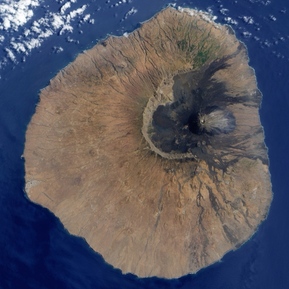
Island boulders reveal ancient mega-tsunami
Massive prehistoric landslide of Cape Verde volcano unleashed waves 170 metres high. The gaping scar in this satellite image tells the tale of the Fogo volcano's eastern-flank collapse.
http://www.nature.com/news/island-boulders-reveal-ancient-mega-tsunami-1.18485
~~~~~~~~~~~~~~~~~~~~~~~~~~~~~~~~~~~~~~~~~~~~~~~~~~~~~~~~~

Cracking open diamonds for messages from the deep earth
Gem-grade diamonds are generally pure crystallized carbon,
but many lower-grade stones contain so-called inclusions–chemical intruders bottled up inside the crystal.
Inclusions lower the stone's value; but they contain worlds of information about the deep, inaccessible regions where diamonds come from.
Read more at: http://phys.org/news/2015-08-diamonds-messages-deep-earth.html#jCp
~~~~~~~~~~~~~~~~~~~~~~~~~~~~~~~~~~
Gem-grade diamonds are generally pure crystallized carbon,
but many lower-grade stones contain so-called inclusions–chemical intruders bottled up inside the crystal.
Inclusions lower the stone's value; but they contain worlds of information about the deep, inaccessible regions where diamonds come from.
Read more at: http://phys.org/news/2015-08-diamonds-messages-deep-earth.html#jCp
~~~~~~~~~~~~~~~~~~~~~~~~~~~~~~~~~~

Plate tectonics may have driven the evolution of life on Earth.
The cycles of nutrients into the oceans following the building of mountains may have been a prime driver of evolutionary change.
From 'The Conversation'
http://tinyurl.com/nr8z6vg

New dinosaur called 'fluffy feathered poodle from hell'
A new feathered dinosaur from China.
see the article from Reuters
http://tinyurl.com/o5d3qpy

The Devonian extinction saw the oceans choke to death.
Thomas Algeo of the University of Cincinnati has put forward a remarkable idea. Maybe the Devonian sea life was killed off by marauding plants.
http://www.bbc.com/earth/story/20150624-the-day-the-oceans-died
≠≠≠≠≠≠≠≠≠≠≠≠≠≠≠≠≠≠≠≠≠≠≠≠≠≠≠≠≠≠≠≠≠≠≠≠≠≠≠≠≠≠≠≠≠≠≠≠≠≠≠≠
Thomas Algeo of the University of Cincinnati has put forward a remarkable idea. Maybe the Devonian sea life was killed off by marauding plants.
http://www.bbc.com/earth/story/20150624-the-day-the-oceans-died
≠≠≠≠≠≠≠≠≠≠≠≠≠≠≠≠≠≠≠≠≠≠≠≠≠≠≠≠≠≠≠≠≠≠≠≠≠≠≠≠≠≠≠≠≠≠≠≠≠≠≠≠

Ten crystals with weird properties that look like magic.
http://www.bbc.com/earth/story/20150623-ten-crystals-with-magic-powers
≠≠≠≠≠≠≠≠≠≠≠≠≠≠≠≠≠≠≠≠≠≠≠≠≠≠≠≠≠≠≠≠≠≠≠≠≠≠≠≠≠≠≠≠≠≠≠≠≠≠≠≠

|
Revealed: the great geologist behind the Origin of Species http://tinyurl.com/puww7kc |
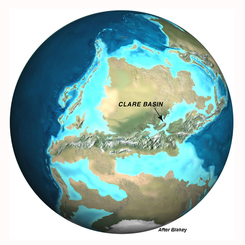
An introduction to the Clare Basin Upper Carboniferous Deepwater Sediments.
From the Society for Sedimentary Geology.
There's a lot more on this site; very educational.
http://www.sepmstrata.org/page.aspx?pageid=154

Snowball Earth events pinned down.
New dates pinpoint start and finish of the Cryogenian. Possibly.
http://earth-pages.co.uk/2015/05/21/snowball-earth-events-pinned-down/
Explore Galway’s Buildings in Stone with the new NUI Galway Guidebook
|
From left: Tom Kenny, who launched the book; Delo Collier, Galway Civic Trust; and co-authors Professor Martin Feely and Dr Alessandra Costanzo, Earth and Ocean Sciences, School of Natural Sciences, NUI Galway City Walks, Buildings in Stone was compiled by NUI Galway’s Professor Martin Feely and Dr Alessandra Costanzo and contains an accompanying street map displays the locations of the buildings described along the course of each of three walks. The three walks are as follows: Walk N1 West of the River Corrib starts at NUI Galway and includes Galway Cathedral, City Museum, Spanish Arch and Blake’s Castle; Walk N2 Galway City Centre highlights the buildings along Quay Street, High Street and Shop Street and includes St Augustine’s Church, St Nicholas’s Collegiate Church and Lynch’s Castle; and Walk N3 Eyre Square Area includes the Allied Irish Bank and Bank of Ireland buildings, Meyrick Hotel and the Railway Station. ≠≠≠≠≠≠≠≠≠≠≠≠≠≠≠≠≠≠≠≠≠≠≠≠≠≠≠≠≠≠≠≠≠≠≠≠≠≠≠≠≠≠≠≠≠≠≠≠≠≠≠≠≠≠≠≠≠≠≠≠≠≠≠≠≠≠≠≠≠≠≠≠≠≠≠≠≠≠≠≠≠≠≠≠≠≠ |
The city’s building stones display a variety of textures and fossils that reflect their geological origins. The walks can be followed by the city's visitors and geologists alike. It will prove very useful for urban geology fieldwork by primary, secondary and third level student parties. It provides an opportunity to study rocks from around the globe including some from China, Finland, Portugal, Italy, South Africa, Norway, Brazil, UK and of course Ireland in a matter of a few hours. The book is an invitation to enjoy learning about the geological heritage that surrounds us in Galway’s inner city.
Co-author Professor Martin Feely said: “Dr Costanzo and I would like to thank Dúchas Na Gaillimhe - Galway Civic Trust for assisting with the publication of this book and in particular Delo Collier for her encouragement during the course of this project.” Local Historian, Tom Kenny, launched the new guide book, the latest in a series of Galway City walks called Buildings in Stone at the Hall of the Red Earl, Druid Lane, Galway. Galway City Walks Buildings in Stone is available at the offices of Dúchas na Gaillimhe - Galway Civic Trust, Druid Lane, priced €5 See our friends Martin and Alessandra talk about the book on IrishTV.ie. http://www.irishtv.ie/category/ireland/connaught/galway/ |
|

One of the ways in which Geology disproves Creationism.
Clue: conglomerate rocks aren't made overnight.
From The Conversation, April 28, 2015.
http://tinyurl.com/kmzhskh

A warning from the past.
They call it the Great Dying because it was the biggest mass extinction in history, and now scientists have discovered the first hard evidence that ocean acidification was the coup-de-grace that killed off more than 90 per cent of marine life 252 million years ago.
http://tinyurl.com/n99n2hr

How one geologist changed a whole country. http://www.bbc.co.uk/radio/player/p02b7hhb
|
|
|
Geologists discover large underground rivers off Galway Bay and the Aran Islands
Galway Advertiser, Thu, Jun 05, 2014
Large networks of underground rivers stretching out off the west coast of Ireland, hidden beneath the Galway Bay seabed, have been discovered by geologists from the School of Natural Sciences at NUI Galway.
The significant discovery was made by the researchers following conversations with residents from Inishmaan on the Aran Islands. Typically, islands experience fresh water shortages, however, the residents of the Aran Islands said their well of fresh water never ran out. The find was futher confirmed from fishermen who refer to freshwater risings along the south coast of Galway Bay.
NUI Galway’s Earth and Ocean Sciences researchers concluded the water was likely to be flowing for several miles before emerging as 'freshwater rivers' out of the sea bed of Galway Bay. This water flow is caused by rain falling on the land, it runs through the limestone and then goes out under the sea.
Research carried out by geologists at NUI Galway identified that the 'freshwater rivers' are formed by water dissolving the limestone that underlies southern Galway and north Clare. This karstification process slowly created not only the distinctive topography of the Burren, but the conduits reaching out under Galway Bay and the Aran Islands, which could be up to 30 miles long and more than 70 foot wide. Wells intersecting these conduits produce more water than falls on the island as rain, indicating that the water is sourced from the mainland.
Dr Tiernan Henry, lecturer in environmental geology at NUIG said, “We were told about a well at a local hotel on Inishmaan that had an excellent supply of fresh water. The islands can have water problems, they are always short, but this well went deep into the rock and was getting more water than falls on the whole island.”
The pure bedded limestones that form the islands are found throughout north Clare and south and east Galway. These rocks are particularly susceptible to dissolution by rainfall, and time, forming the distinctive drainage patterns of turloughs, swallow holes, sink holes, and sinking rivers. Almost all of the fresh water in these areas flows in discrete zones within the rock discharging in springs found at the coast and in the bays and sea. The means by which these passages and conduits form is well known and well understood, but where they form, and the shapes they take are less easy to predict.
The research was funded by the Griffiths Award and supported by the university’s Ryan Institute for Environmental, Marine, and Energy Research. For more information, visit the School of Natural Sciences at http://www.nuigalway.ie/natural_sciences/ or the School of Earth and Ocean Sciences at http://www.nuigalway.ie/eos
Galway Advertiser, Thu, Jun 05, 2014
Large networks of underground rivers stretching out off the west coast of Ireland, hidden beneath the Galway Bay seabed, have been discovered by geologists from the School of Natural Sciences at NUI Galway.
The significant discovery was made by the researchers following conversations with residents from Inishmaan on the Aran Islands. Typically, islands experience fresh water shortages, however, the residents of the Aran Islands said their well of fresh water never ran out. The find was futher confirmed from fishermen who refer to freshwater risings along the south coast of Galway Bay.
NUI Galway’s Earth and Ocean Sciences researchers concluded the water was likely to be flowing for several miles before emerging as 'freshwater rivers' out of the sea bed of Galway Bay. This water flow is caused by rain falling on the land, it runs through the limestone and then goes out under the sea.
Research carried out by geologists at NUI Galway identified that the 'freshwater rivers' are formed by water dissolving the limestone that underlies southern Galway and north Clare. This karstification process slowly created not only the distinctive topography of the Burren, but the conduits reaching out under Galway Bay and the Aran Islands, which could be up to 30 miles long and more than 70 foot wide. Wells intersecting these conduits produce more water than falls on the island as rain, indicating that the water is sourced from the mainland.
Dr Tiernan Henry, lecturer in environmental geology at NUIG said, “We were told about a well at a local hotel on Inishmaan that had an excellent supply of fresh water. The islands can have water problems, they are always short, but this well went deep into the rock and was getting more water than falls on the whole island.”
The pure bedded limestones that form the islands are found throughout north Clare and south and east Galway. These rocks are particularly susceptible to dissolution by rainfall, and time, forming the distinctive drainage patterns of turloughs, swallow holes, sink holes, and sinking rivers. Almost all of the fresh water in these areas flows in discrete zones within the rock discharging in springs found at the coast and in the bays and sea. The means by which these passages and conduits form is well known and well understood, but where they form, and the shapes they take are less easy to predict.
The research was funded by the Griffiths Award and supported by the university’s Ryan Institute for Environmental, Marine, and Energy Research. For more information, visit the School of Natural Sciences at http://www.nuigalway.ie/natural_sciences/ or the School of Earth and Ocean Sciences at http://www.nuigalway.ie/eos
================================================================================
For information on the GGA and membership please contact us at galwaygeology'at'gmail.com
For information on the GGA and membership please contact us at galwaygeology'at'gmail.com




